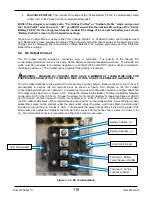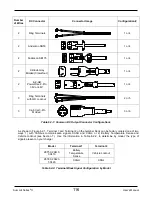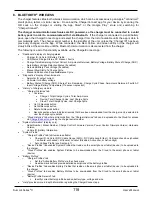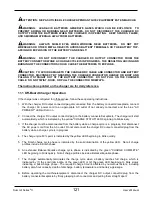
Summit Series
®
II
User’s Manual
13. TROUBLESHOOTING
The charger was fully tested and calibrated before leaving the factory. It was delivered ready to charge. If
properly installed, the charger should require very little attention. If improper charger operation occurs, it will
require repair by a qualified service technician (see section 12.1 for information regarding the Fault LED).
CAUTION: DO NOT OPERATE THE CHARGER IF IT IS DAMAGED OR APPEARS TO BE
MALFUNCTIONING. PERSONAL INJURY OR DAMAGE TO THE CHARGER OR BATTERIES MAY
RESULT. DO NOT DISASSEMBLE THE CHARGER. CONTACT YOUR DEALER. INCORRECT
REASSEMBLY MAY RESULT IN RISK OF ELECTRIC SHOCK OR FIRE.
1. If the charger does not turn on, check for one of the following conditions.
a. The charger AC power cord is not plugged into a live and/or appropriate AC outlet.
b. The battery connections are incorrect – battery not connected, reverse polarity, or short circuit.
c. The battery voltage is too high.
d. The battery voltage is too low (below 10 volts).
2. If the charger turns off before a battery is fully charged, and a fault condition is not indicated by the Fault
LED, this indicates one of the following conditions.
a. The AC power was interrupted during the charge cycle.
b. The charger DC output connector was disconnected from the battery during the charge cycle.
c. The battery has been allowed to sulfate. Charge the battery at least once every three (3) days when
the equipment is lightly used. Once sulfation is allowed to take place, it may be partially reduced by
returning, temporarily, to daily charging.
3. A decrease in vehicle/equipment range where the battery loses power faster indicates one of the
following conditions.
a. The electrolyte level in a wet lead-acid battery was allowed to drop below the top of the battery plates.
If so, add distilled water to just cover the top of the plates immediately upon discovery, and then fill to
the proper level with distilled water at the completion of the very next charge cycle.
b. Use of the vehicle/equipment before the battery has been fully charged and the charger automatically
terminates the charge cycle. This shortens battery life and accelerates the onset of reduced daily
range.
c. The normal wear-out pattern for the battery.
4. A charge cycle running longer than anticipated before terminating indicates one of the following
conditions.
a. An overly-discharged battery.
b. The charger output may have been reduced due to low AC input voltage, high ambient temperature,
or obstructions to cooling airflow.
c. The amp-hour capacity of the battery is greater than the charger can fully charge in the anticipated
amount of time.
14. SPECIFICATIONS
See the 1050W Summit II datasheet for specifications.
The Bluetooth
®
word mark and logos are registered trademarks owned by Bluetooth SIG, Inc., and any use of such marks by Lester
Electrical is under license. Other trademarks and trade names are those of their respective owners.
Apple is a trademark of Apple Inc., registered in the U.S. and other countries. App Store is a service mark of Apple Inc., registered in the
U.S. and other countries.
Android is a trademark of Google Inc. Google Play and the Google Play logo are trademarks of Google Inc.
126
Содержание eNVy neighborhood vehicle
Страница 1: ...OWNER S MANUAL 1 ...
Страница 56: ...Accessories For a complete line of genuine eNVy accessories visit www baddawgaccessories com 56 ...
Страница 58: ...Service Record Number Date Hour Meter Reading Dealer Stamp 1 2 3 4 5 6 7 8 58 ...
Страница 61: ...Golf Cart Battery Install Maintenance 61 ...
Страница 71: ...OCV Open Circuit Voltage vs SOC State of Charge 71 ...
Страница 92: ...92 ...
Страница 94: ...94 ...
Страница 96: ...96 ...
Страница 128: ...Summit Series II User s Manual Represented By 43068 B 128 ...



































